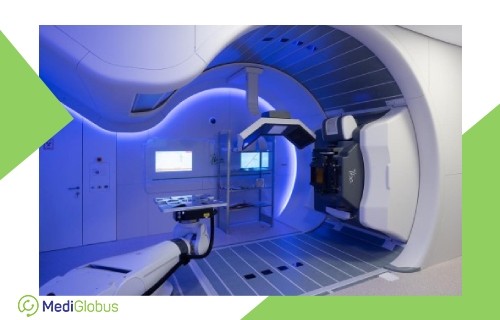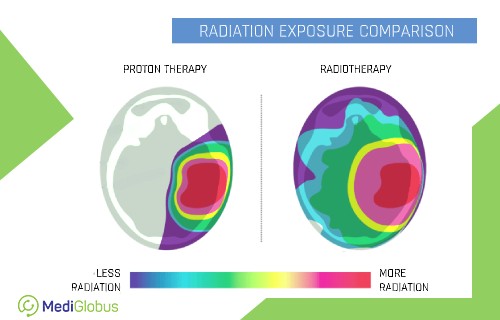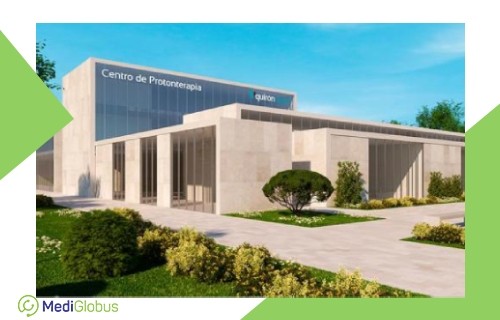1. Benefits of proton therapy |
2. How does the treatment work? |
3. Benefits of the Quironsalud Proton Therapy Centre |
4. The treatment process |
5. Features of the Quironsalud Proton Therapy Centre |
In a recent article about Flash therapy, we promised to tell you more about modern, effective and safe cancer treatments. One of them is proton therapy. In 2019, the first Proton Therapy Centre was opened in Spain at the Quironsalud Hospital. According to a 2019 study published in Radiotherapy and Oncology, the three-year survival rate for women with breast cancer without metastases who have undergone proton therapy is 97.2%. For men with uncomplicated prostate cancer, this number rises to 99%. In Europe, there are only 34 facilities where this treatment is available. Learn more about the possibilities of this innovative method in the article below.
What is proton therapy?
Today, the main methods of cancer treatment are surgery, chemotherapy, and radiotherapy. Doctors have achieved great results in improving these methods, but they have one significant drawback: along with the destruction of tumours, the healthy cells around the tumour get damaged. Up to 60% of radiation falls on them. Therefore, scientists have set themselves the task of finding new methods of cancer treatment that would be even more effective, but safer.
The solution is proton therapy. If a traditional course of radiotherapy uses X-ray radiation, the new method instead employs positively charged particles – protons.
An apparatus called a cyclotron or synchrotron accelerates protons to 2/3 of the speed of light. In this state, protons begin to emit large amounts of energy and this allows them to penetrate through human tissue.
Although proton therapy is still radioactive, unlike radiotherapy, it is more delicate. The degree of precision of the proton unit is 1 mm, compared to 2-5 mm in radiotherapy. This means that the healthy tissue around the tumour is less irradiated, but cancer decays more rapidly.

More than 300,000 people have already undergone proton therapy.
Type of procedure: | proton therapy |
Anesthetics: | not needed |
Duration: | 15-30 minutes |
Hospitalization: | not needed |
Side effects: | fatigue and skin issues: redness, dryness, itchiness, flakiness, swelling. |
What kinds of cancer are treated with proton therapy?
Brain and spine cancer;
Eye tumours;
Head and neck cancer;
Lung cancer;
Liver cancer;
Prostate cancer;
Bone and soft tissue cancer;;
Benign tumors.
Not all cancers are currently treatable with proton therapy. Most often it is prescribed for non-metastasic tumours that are close to important organs.
Proton therapy proved itself especially useful in the treatment of children’s cancer. This is due to the minimal radiation exposure of healthy growing tissue. For example, the survival rate of children with brain ependymoma reaches 90% (according to a study published in Acta Oncologica).
To make an appointment for proton therapy for cancer in Spain, click on the button below and fill out the form. Our coordinating doctors will help you to solve all organisational issues, get a quick response from the clinic, and will accompany and support you during all stages of treatment.
What are the benefits of proton therapy?
Reduced radiation exposure to healthy tissue;
Can be used on patients with kidney failure;
Safer for children;
Stronger reducing effect on cancer cells;
Fewer side effects such as nausea, dizziness, vomiting, reduced blood count;
Quicker and requires fewer sessions;
Better quality of life.

Among men with prostate cancer who underwent proton therapy, subsequent complications were observed in 1%. For prostatectomy, this figure is 28,6%.
How is proton therapy performed at Quironsalud Hospital?

Beforehand, you will need to have a CT or MRI scan. This will allow doctors to determine the exact location of the tumour that needs to be irradiated.
The procedure is painless.
The medical team includes radiologists, oncologists, radiooncologists, dosimetrists, radiophysicians, and nurses. They calculate the required dosage of protons and the most effective way of administration.
Quironsalud Madrid uses Proteus One device. It has high-precision tumour scanning technology. The design allows the ray to spin around the patient by 220°, irradiating the malignancy at different angles.
The patient needs to remain immobile during treatment. For people with certain types of cancer, such as head and neck tumours, it can be difficult. For this reason, specially designed medical “masks” fix the position of the body during treatment. To reduce the patient’s anxiety, the process can be accompanied by a soothing video with atmospheric lighting and images of nature.
A team of doctors marks the boundaries of the tumour on the patient’s body so as not to damage the healthy tissue. A similar procedure is performed during conventional radiotherapy.
The number of sessions and their duration depend on the type and size of the tumour. Usually, 1-5 treatments are enough. Sometimes their duration may differ from one another: for example, on one day the doctor will irradiate the main tumour tissues, and on another day – nearby lymph nodes. As a rule, the fewer sessions are held, the more proton power is used. If proton therapy is limited to a single intervention, this is called radiosurgery.
The number and severity of side effects are less than with other treatments. At the same time, they may be present, especially if the patient is also undergoing chemotherapy. This problem can be solved by the nursing staff and the oncologist treating the patient.
What are the features of the Quironsalud Proton Therapy Center in Spain?
The new Proton Therapy Center can accommodate 400 patients per year. Soon, the hospital plans to double this number to 800 patients. Almost half of the cancer patients admitted for treatment are children.
Proteus One at the Proton Therapy Center is the most advanced in its lineup. Its system is optimized for use in the treatment of a wide variety of cancers. This model uses energy-efficient cryogenic technologies. With time, it will be updated with new technologies that are now in development, specifically, and also include improvements. with the addition of new features that are already in the research phase. These include rotation therapy and ultra-high-intensity Flash radiation.
In addition, the Proton Therapy Center in Spain has an advantage for late-stage cancer patients from European and Asian countries. For people in these states, flights can sometimes be dangerous. Therefore, they will be able to reach the hospital by ground, without putting their health at unnecessary risk.
Importantly, the clinics of the Quironsalud Network have international quality certificates DNV-GL, EFQM, and ISO, which testify to the high standards of medical care. In 2022, the hospital was included in the list of “Top 12 hospitals in Spain with the best reputation” according to Monitor de Reputación Sanitaria.
Summary
The Quironsalud Proton Therapy Centre in Madrid is one of the best proton therapy cancer treatment options in Europe. It combines the expertise of Spain’s best oncologists and radiologists, state-of-the-art equipment (Proteus One), a caring attitude towards international patients and democratic prices.
Proton therapy is used as an alternative to radiation therapy for certain types of cancers, in particular: brain and spinal cord tumours, head and neck tumours, eye tumours, lung, liver, prostate, bone and soft tissue cancers.
Proton therapy irradiates healthy tissues to a lesser extent, which is the main advantage of this method. It plays a particularly important role in the treatment of cancer in children.
Usually, 1-5 treatments are sufficient to treat cancer with proton therapy. Five-year survival rate of patients who have undergone this type of treatment is quite high (up to 97,2% for breast cancer, up to 99% for prostate cancer, and up to 90% for brain ependymoma – in case of uncomplicated forms of diseases).
Proton therapy is a good alternative to radiation therapy, for example, for people with kidney failure or children. To register for treatment at the Quironsalud Madrid Proton Center Madrid, leave your application on the Mediglobus website and our coordinators will contact you.
Sources:
- 1. American Society of Clinical Oncology
- 2. Radiotherapy and Oncology: Early outcomes of breast cancer patients treated with post-mastectomy uniform scanning proton therapy
- 3. JAMA Oncology: Comparative Effectiveness of Proton vs Photon Therapy as Part of Concurrent Chemoradiotherapy for Locally Advanced Cancer
- 4. Acta Oncologica: Outcomes following proton therapy for pediatric ependymoma






